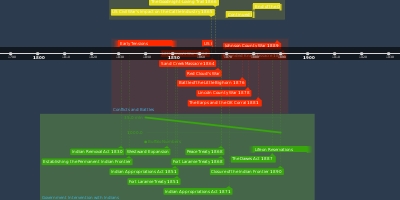Indian Culture and Beliefs (1 ene 1830 año – 1 ene 1900 año)
Descripción:
Structure of Plains Indian SocietyEach tribe was made up of different ‘bands’ with the size of each band ranging from 20 to hundreds of people.
In charge of each tribe were chiefs. Chiefs were always male and were chosen because of their wisdom and skill. Tribes usually had several chiefs who were in charge of different aspects of tribal life. Each band also had a ‘band chief’. These men were responsible for the safety of their individual band. Finally, each tribe also had warrior brotherhoods. Warrior brotherhoods were groups of young men who were renowned for their fighting skills and bravery. They would defend their tribe in a war and sometimes raid neighbouring tribes for goods.
Important decisions about a tribe were made at the tribe’s council. The tribe’s council consisted of the chiefs, band chiefs, and elders. Important issues would be discussed and no decisions would be made unless everyone agreed.
It is important to note that in many tribes the chiefs and tribe councils had no power to command all of their people. Bands ultimately made their own decisions. Likewise, warrior brotherhoods did not have to follow the chief’s or council’s will. This is important as it caused confusion and tension between the US government and Plains Indians. Often the US government would make formal treaties and agreements with chiefs. However, individual Plains Indians would break the terms of these treaties as they were under no obligation to follow their chief’s instruction. The US government found this both confusing and frustrating.
Survival on the Great Plains
Conditions on the Great Plains were harsh. Temperatures were extreme with freezing cold winters and incredibly hot summers. Lightning flashes could cause the grass to set alight, causing huge grassfires that spread across the Plains. The land was dry and unproductive making it difficult to grow crops. Furthermore, dangerous animals, such as buffalo, roamed free.
The Plains Indians had adapted their way of life in order to live in these difficult conditions. Their survival depended on hunting buffalo. The Plains Indians acquired the vast majority of their food and materials from these animals. They therefore developed a nomadic lifestyle in which they would follow the buffalo migrations across the Plains.
Plains Indians lived in tipis, which could easily be taken down and transported when necessary. They had incredible horse-riding and archery skills, which allowed them to effectively hunt buffalo and travel across the Plains. Finally, they developed skills which allowed them to utilise every part of the buffalo.
Importance of the Buffalo
The buffalo were incredibly important to the Plains Indians; their way of life and survival depended on them. Since there were so few resources on the Great Plains, the Plains Indians developed skills to use as much as the buffalo as possible.
• Horns - arrows, cups, and spoons
• Fat - cooking, hair grease, soap
• Fur - clothes, stuffing, mittens
• Tanned hide - bags, blankets, clothes, toys, saddles
• Rawhide - bags, belts, lashings, shields
• Tail - ornament, whips, fly swats
• Bladder - food bag
• Tendons - bowstring of an arrow, thread
• Dung - fuel and to smoke
• Bones – arrows, dice, jewellery, knives, needles, shovels, tools
• Gall – to make paint
• Liver - food
• Intensities - buckets, cooking pots
• Hooves – glue, toys, tools
• Tongue - hairbrush, sometimes eaten raw
• Brain - tanning the hides
• Skull – used in religious ceremonies
• Heart - cut from the body and left on the ground as a sign of respect
Anything that affected the buffalo, or Plains Indians access to the buffalo, therefore had a massive impact on the Plains Indian’s way of life.
Beliefs about Nature and Land
Plains Indians believed that everything in nature had a spirit. This included animals, plants, rocks, rivers and human beings. Plains Indians believed they should work together with the spirits rather than trying to control them.
It was believed spirits could be contacted through visions and ceremonial dances. Visions were very important to Plains Indians and helped them make important decisions throughout their lives.
This deep belief in spirits meant that Plains Indians regarded land as sacred. Some tribes therefore believed farming the land was disrespectful as it was an attempt to control it. Plains Indians also believed that it was wrong for an individual or a family to privately own land.
White Americans often misunderstood the Plains Indians beliefs about nature and land and it became the greatest source of conflict between the two groups.
Beliefs about War
Plains Indians had distinct beliefs about war. They did not aim to conquer land, as they did not believe individuals could own land. Instead they fought for hunting and living space, as well as for resources such as goods, horses and weapons.
Young men were incredibly valuable to tribes as they were the main hunters and protectors. Plains Indians therefore developed methods to reduce the number of young men dying in conflict. For example, Plains Indians did not think it was heroic to die in battle. If they were outnumbered, Plains Indians would run away so that they could continue to provide for their tribe.
Plains Indians also practiced the ‘counting coup’. It was considered braver to get close enough to your enemy that you can touch them (to ‘count coup’) than to kill them from a distance using weapons. Warriors who had been touched would have to stay still until they were rescued by someone from their tribe, or until the battle ended. This meant casualties were kept to a minimum.
Añadido al timeline:
fecha:
1 ene 1830 año
1 ene 1900 año
~ 70 years
